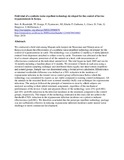| dc.contributor.author | Bett, B | |
| dc.contributor.author | Randolph, TF | |
| dc.contributor.author | Irungu, P | |
| dc.contributor.author | Nyamwaro, SO | |
| dc.contributor.author | Kitala, P | |
| dc.contributor.author | Gathuma, J, | |
| dc.contributor.author | Grace, D | |
| dc.contributor.author | Vale, G | |
| dc.contributor.author | Hargrove, J | |
| dc.contributor.author | McDermott, J | |
| dc.date.accessioned | 2013-06-17T11:56:06Z | |
| dc.date.available | 2013-06-17T11:56:06Z | |
| dc.date.issued | 2010 | |
| dc.identifier.citation | Bett B, Randolph TF, Irungu P, Nyamwaro SO, Kitala P, Gathuma J, Grace D, Vale G, Hargrove J, McDermott J Field trial of a synthetic tsetse-repellent technology developed for the control of bovine trypanosomosis in Kenya., Preventive Veterinary Medicine [2010, 97(3-4):220-227] | en |
| dc.identifier.uri | http://europepmc.org/abstract/MED/20980070 | |
| dc.identifier.uri | http://erepository.uonbi.ac.ke:8080/xmlui/handle/123456789/34883 | |
| dc.description.abstract | We conducted a field trial among Maasai cattle-keepers in Nkuruman and Nkineji areas of Kenya to evaluate the effectiveness of a synthetic tsetse-repellent technology developed for the control of trypanosomosis in cattle. The technology was a repellent (2-methoxy 4-methylphenol) emitted from dispensers attached to collars worn by cattle. Treatment was allocated at the herd level to ensure adequate protection of all the animals in a herd, with measurements of effectiveness conducted at the individual-animal level. The trial began in April 2005 and ran for 16 months including a baseline phase of 4 months. We recruited 12 herds in each area using a restricted random-sampling technique and distributed them equally into intervention (repellent) and control groups. Sample size was determined using a formal power calculation. Effectiveness or minimal worthwhile difference was defined as a 50% reduction in the incidence of trypanosome infection in the treated versus control group (effectiveness below which the technology was considered by experts as not viable compared to existing control techniques). All the animals in the recruited herds were screened monthly (buffy-coat technique) for trypanosome infections. The analysis followed the principle of intention-to-treat by which subjects are analysed according to their initial treatment assignment, regardless of the mechanical performance of the device. Crude and adjusted effects of the technology were 23% (p<0.001) and 18% (p=0.08) reduction in the infection incidence in the treatment compared to the control groups, respectively. The impact of the technology estimated in this study did not achieve the threshold of 50% reduction in the trypanosome infection incidence set a priori to indicate effectiveness (p<0.001). We therefore concluded that the prototype repellent technology package was not sufficiently effective in reducing trypanosome infection incidence under natural tsetse challenge to merit commercial development. | en |
| dc.language.iso | en | en |
| dc.publisher | University of Nairobi, | en |
| dc.title | Field trial of a synthetic tsetse-repellent technology developed for the control of bovine trypanosomosis in Kenya. | en |
| dc.type | Article | en |

